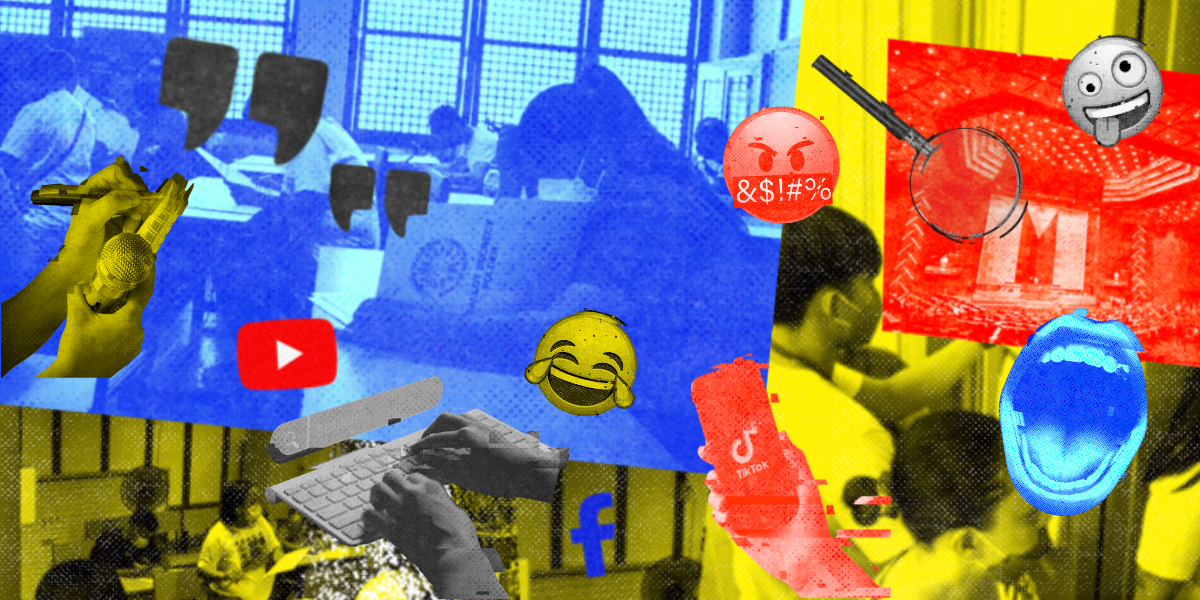It’s (dog)show time!: How political shitposting contributes to the Philippine misinformation epidemic
Social media interactions have become their medium.
A “like” can be taken as concurrence, an “unfollow” may be interpreted as a personal choice or a conclusion, and a “laugh” reaction is often used to show irony or amusement. Through these interactions, social media users could curate their lingo, making it easily digestible for seconds’ worth of scrolling.
One of the most common forms of engagement is “shitposting.” Whether a video, meme, thread, or comment, shitposting is an act of posting content online that is deliberately absurd, provocative, or offensive. These shitposts have become normal occurrences to us because they appeal to certain niches or ride on the coattails of trending events. In essence, they are satirical posts reserved for entertainment only, when users intend them to be.
While shitposts may be made solely for entertainment and are not meant to cause harm, the sheer heterogeneity in how social media users behave and interact can lead to consequences. One post can garner several reactions, all made visual through numbers and longevity on a platform to give the illusion of reacting and thinking similarly to everybody else. Whether knowingly or unknowingly, the comments, likes, and engagements made by social media users also influence how we discern fact from folly or how we interpret the media we consume, posing a risk to potentially drive the spread of misinformation.
‘Fake news ka’
Filipinos are no strangers to fake news, to the point that we even use it as an expression—“fake news ka”—when calling out someone who gives false information.
The misinformation epidemic in the Philippines has been long standing, but it perhaps becomes most apparent during the political campaign and election periods. Analysis conducted by the #FactsFirstPH team and published on Rappler revealed that during the 2016 and 2019 elections, false and misleading claims had amassed 4.6 million interactions across various social media platforms. The results were based on 135 sampled claims, 73 of which were falsehoods, 40 were marked as hoaxes, and 19 were indicated as misleading.
In comparison, the 2022 elections saw both misinformation and the corresponding social media interactions skyrocket. Out of the 256 claims analyzed, a staggering 80 percent of them (207) were false, while 39 lacked the context and nuance necessary for correct interpretation. Moreover, these claims gathered a total of 67.48 million interactions, a 15-fold increase compared to the previous election period analyzed. Facebook was the consistent top culprit, while Youtube and TikTok were subsequent additions to the metrics.
Projections based on these numbers suggest that a significant portion of social media users in the tens of millions were exposed to fake news or were unaware of the falsity of the posts they interacted with. These numbers, however drastic, seemed to have especially benefited political figures who have a strong social media presence.
Recently, following the arrest of former President Rodrigo Roa Duterte, a slew of quote cards with fake statements from fictional lawyers in TV series and movies were posted by social media users across different platforms. Some may view this as mere humor, but due to its amplification, many users have resorted to posting more quote cards with false statements. Tons of interactions were also elicited due to users who interacted with the posts and did not realize that they were made up.
Reports also show that several videos were spliced and edited as Facebook reels. Consequently, these were taken out of context and accumulated a large volume of interactions.
These numbers and many more cases highlight the ramifications of amplifying shitposts and potentially misleading content. Even if we only spend mere seconds on a post, a ripple effect of repercussions can already unfold—faster than we can say, “fake news ka.”
Influencer operations
With social media establishing itself as a modern tool for political propaganda, users must be wary and skeptical of the posts they encounter on social media.
Ferdinand Sanchez III, a researcher whose areas of focus are disinformation, deliberative democracy, and Filipino masculinities, likens satirical posts in the form of shitposting to engagement farming, especially during election season. Garnering reactions depend on appealing to an audience with similar viewpoints, poking fun at the subject of the post. It can also serve as a form of “rage baiting” to spark reactions from individuals with different political views.
Shitposts or satires are usually meant as a critique of social issues. However, for Sanchez, the satirical potential of a post is lost when it becomes viral, subjecting the contents to the audience’s opinions and active reactions.
Whether the engagement is positive or negative, context can still get lost along the way, and even shitposts based on facts can unwittingly turn into misconstrued content used for a different agenda. When this happens, and the negative impacts become more salient, the subsequent repercussions become difficult to mitigate, Sanchez remarks. Hence, interpreting shitposts without precaution or a critical lens can lead to misinformation and disinformation—especially in the context of the Philippines.
More importantly, the dangers of fake news are not just limited to the grand scheme of things, it also affects our relationships and personal opinions. It could lead to distrust, mistakes, and miscommunication, unknowingly becoming bearers of fake news ourselves.
The algorithm on our social media platforms feeds us content with our engagement patterns as a basis. It also tries to integrate our interests and points of view, but even if there is a system that operates to provide us with our desired or preferred online experience, we can still work toward alleviating the fake news epidemic we are facing.
Everyone’s a fact-checker
A multisectoral approach may be the key to addressing the misinformation epidemic. Fact-checking and verifying information will not be restricted to journalists, researchers, or designated fact-checkers; instead, everyday social media users can also be actively involved in countering the spread of false or misleading content.
The everyday netizen benefits from learning about the fact-checking process, understanding how to evaluate the accuracy of information presented. When people are aware of the process, they gradually become acclimated to it, making it a habit to verify the facts before forming opinions or making decisions.
Evidently, building up to a digital community that can critically evaluate each and every post they encounter is more of an ideal, and certainly not a transformation that can happen overnight. Misinformation and disinformation continue to run rampant on different platforms, but at this point, days before the 2025 midterm elections, what else can we do?
We are often advised to think before clicking, and this includes keeping an open yet critical mind when engaging with shitposts and content covering sociopolitical issues. It is important to seek out reliable sources to learn more about each candidate’s platforms. We can take the time to do a bit of fact-checking on our own, bearing in mind to consider contextual nuance when interpreting posts, satirical or otherwise.
Now is the time to go beyond the numbers game of social media. Now is the time to decide and choose candidates based upon principle, needs, and preferences, not just on the volume of likes and laughs on a post or the followers an “influencer” may have.
We have control over the votes we cast and how or why we choose certain candidates; it is best that we equip this freedom of choice with sufficient knowledge and facts, to the best of our time and abilities.
May we have a peaceful and safe election.







